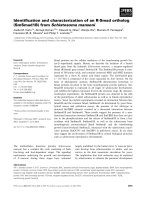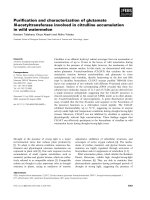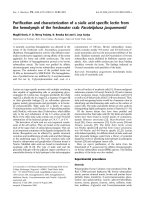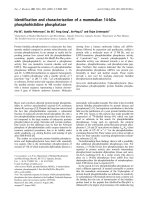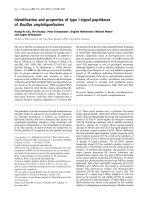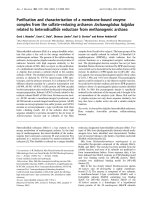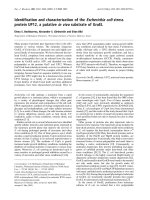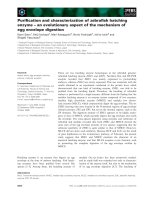Báo cáo Y học: Identification and characterization of a new gene from Variovorax paradoxus Iso1 encoding N -acyl-D-amino acid amidohydrolase responsible for D-amino acid production pdf
Bạn đang xem bản rút gọn của tài liệu. Xem và tải ngay bản đầy đủ của tài liệu tại đây (853.76 KB, 11 trang )
Identification and characterization of a new gene from
Variovorax
paradoxus
Iso1 encoding
N
-acyl-
D
-amino acid amidohydrolase
responsible for
D
-amino acid production
Pei-Hsun Lin
1
, Shiun-Cheng Su
1
, Ying-Chieh Tsai
2
and Chia-Yin Lee
1
1
Graduate Institute of Agricultural Chemistry, National Taiwan University, Taipei, Taiwan;
2
Graduate Institute of Biochemistry,
Yang-Ming University, Taipei, Taiwan
An N-acyl-
D
-amino acid amidohydrolase (N-D-AAase) was
identified in cell extracts of a strain, Iso1, isolated from an
environment containing N-acetyl-
D
-methionine. The bac-
terium was classified as Variovorax paradoxus by phylo-
genetic analysis. The gene was cloned and sequenced. The
gene consisted of a 1467-bp ORF encoding a polypeptide of
488 amino acids. The V. paradoxus N-D-AAase showed
significant amino acid similarity to the N-acyl-
D
-amino acid
amidohydrolases of the two eubacteria Alcaligenes xylo-
soxydans A-6 (44–56% identity), Alcaligenes facelis DA1
(54% identity) and the hyperthermophilic archaeon Pyro-
coccus abyssi (42% identity). After over-expression of the
N-D-AAase protein in Escherichia coli, the enzyme was
purified by multistep chromatography. The native molecular
mass was 52.8 kDa, which agreed with the predicted
molecular mass of 52 798 Da and the enzyme appeared to be
a monomer protein by gel-filtration chromatography. A
homogenous protein with a specific activity of 516 UÆmg
)1
was finally obtained. After peptide sequencing by LC/MS/
MS, the results were in agreement with the deduced amino
acid sequence of the N-D-AAase. The pI of the enzyme was
5.12 and it had an optimal pH and temperature of 7.5 and
50 °C, respectively. After 30 min heat treatment at 45 °C,
between pH 6 and pH 8, 80% activity remained. The
N-D-AAase had higher hydrolysing activity against N-ace-
tyl-
D
-amino acid derivates containing
D
-methionine,
D
-leucine and
D
-alanine and against N-chloroacetyl-
D
-phe-
nylalanine. Importantly, the enzyme does not act on the
N-acetyl-
L
-amino acid derivatives. The enzyme was inhibited
by chelating agents and certain metal ions, but was activated
by1m
M
of Co
2+
and Mg
2+
. Thus, the N-D-AAase from
V. paradoxus can be considered a chiral specific and metal-
dependent enzyme.
Keywords: N-acyl-
D
-amino acid amidohydrolase;
D
-amino
acid; LC/MS/MS; Variovorax paradoxus.
D
-Amino acids are important materials for chiral chemical
synthesis of such things as semi-synthetic antibiotics [1–3],
bioactive peptide [4–6], pyrethrods, pesticides and some
food additives such as altimate [7,8]. They can also be used
to synthesize
D
-configuration specific
D
-amino acid deriva-
tives [9,10].
D
-amino acids also are important constituents of
eubacterial cell walls [11]. They are found in microorga-
nisms, plants and animals and their function and physio-
logical roles have been investigated and identified [12,13].
N-acyl-
D
-amidohydrolase (EC.3.5.1.81, N-D-AAase) is an
enzyme capable of catalysing the hydrolysis of N-acyl-
D
-amino acids to yield the corresponding
D
-amino acid and
the organic acid. They have been found in a number of bac-
terial species, including members of the Alcaligenes, Strep-
tomyces, Pseudomonas, Stenotrophomonas, Amycolatopsis
and Sebekia [14–22]. So far, all N-D-AAases characterized
consist of monomeric proteins of 45–55 kDa except for
the Pseudomonas sp. 1158 enzyme which has a molecular
mass of 100 kDa and the Amycolatopsis enzyme which has
a molecular mass of 36 kDa. They have similar optimal
temperatures (45–50 °C) and pHs [7,8] but show a variety of
different specific activities towards different substrates. The
enzyme is inhibited by metallic ions such as Zn
2+
,Hg
2+
,
Cu
2+
and by EDTA. Notably, the enzymes purified from
Streptomyces olivaceus and Amycolatopsis orientalis
IFO12806 are activated by Co
2+
(1 m
M
). Some purified
enzymes have been found to contain between 2.06 g and
2.61 g Zn per mole and it is considered that zinc ions may
play a role in the catalytic activity and stability of the
enzyme structure [23–25].
Up to this point, it is not clear what the function of
N-D-AAase is in bacteria, and gene sequence information is
available only from Alicaligenes species [26–28].
D
-amino
acids are very important for the synthesis of intermediate
chiral compounds as mentioned earlier and some reports
have described enzymatic methods for the synthesis of
D
-amino acids [29–32], including the coupling in a process of
N-D-AAase and N-acylamino acid racemase. However,
some N-D-AAases isolated from bacteria have some
L
-aminoacylase activity [18,33]. Therefore, it is necessary
to avoid
L
-aminoacylase interference if the enzyme is to be
Correspondence to C Y.Lee,GraduateInstituteofAgricultural
Chemistry, National Taiwan University, 1, Sec. 4, Roosevelt Road.,
Taipei 106, Taiwan.
Fax: +886 2 2366 0581, Tel.: +886 2 2363 0231, extn 2816.
E-mail:
Abbreviations: N-D-AAase, N-acyl-
D
-amidohydrolase; HSL, homo-
serine lactone; C4-HSL, N-butanoyl-homoserine lactone.
Enzyme: N-acyl-
D
-amidohydrolase (N-D-AAase, EC.3.5.1.81).
(Received 30 June 2002, revised 14 August 2002,
accepted 20 August 2002)
Eur. J. Biochem. 269, 4868–4878 (2002) Ó FEBS 2002 doi:10.1046/j.1432-1033.2002.03190.x
used in industrial applications. In this study, a strain, Iso1,
with N-D-AAase enzyme activity, was isolated from the
environment and the gene for the enzyme was cloned and
then sequenced. The recombinant protein, N-D-AAase, was
also produced in the Escherichia coli, purified and charac-
terized.
MATERIALS AND METHODS
Bacterial strains, plasmids and conditions
Variovorax paradoxus Iso1 was isolated from an environ-
mental situation containing N-acetyl-
D
-methionine. It was
grown at 30 °C in TSB (Difco) medium and used as a
source of its chromosomal DNA. E. coli XL1-Blue [34] and
E. coli Top10 grown at 35 °C in Luria–Bertani broth
(Difco) were used as the host for gene cloning and
expression. Luria–Bertani medium supplemented with
100 mgÆmL
)1
ampicillin (Sigma) was used for plasmid
maintenance. Two plasmids pBluescript II KS(+) (Stra-
tagene) and pTrcHis2A (Invitrogen) were used as gene
cloning and expression vectors, respectively. For protein
expression, E. coli Top10 containing recombinant plasmids
was grown in 2YT medium supplemented with
200 mgÆmL
)1
ampicillin. Under the trc promoter and lac
q
repressor of pTrcHis2A, isopropyl thio-b-
D
-galactoside was
added to a final concentration of 1 m
M
.
Materials, enzymes and chemicals
Restriction enzymes and T4 DNA ligase were from New
BioLabs and Gibco BRL. Pfu DNA polymerase and
alkaline phosphatase were from Promega and Boehringer
Mannheim, respectively.
D
-Amino acid oxidase (EC 1.4.3.3)
from porcine kidney and horseradish peroxidase were
purchased from Sigma Chemical Co. DEAE-Toyopearl
650 M and Butyl-Toyopearl 650 M were from Tosoh
(Tokyo, Japan). FPLC-Mono Q was from Pharmacia.
Substrates and standards were from commercial sources
such as Sigma or Bachem. All other reagents were the
highest grade available.
16S rDNA gene sequence analysis
The nucleotide sequence of the 16S rDNA from strain Iso1
was amplified by PCR using proof reading Pfu DNA
polymerase. The universal primers 5F (5¢-TGAAGAGTTT
GATCATGGCT-3¢) and 1540R (5¢-AAGGAGGTGAT
CCAACCGCA-3¢) numbered according to the E. coli 16S
rRNA sequence were used. The PCR product was purified
and ligated into the p-GEM-T Easy Vector system
(Promega) [35]. DNA sequencing was carried out using
an ABI Prism 3770 DNA sequencer (Perkin Elmer).
Comparison with other 16S rDNA sequences was per-
formed by the
BLAST
program [36] against GenBank. The
sequence alignment analysis was carried out using
CLUSTAL
W
[37]. The
PHYLIP
software package was used for phylo-
genetic analysis and
TREE VIEW
32wasusedtoviewthe
phylogenic trees [38]. The reliability of the each tree node
was confirmed by bootstrapping (1000 trees) and a consen-
sus tree was constructed using
SEQBOOT
and
CONSENSE
from
the
PHYLIP
package. The GenBank accession number for
the strain Iso1 is AY127900.
Cloning of
V. paradoxus N
-D-AAase gene
Recombinant DNA technology was carried out by the
standard methods of Sambrook et al.[39].Totalgenomic
DNA was prepared from V. paradoxus Iso1 by a modified
method, and partially digested with Sau3AI. The 3 kb to
9 kb DNA fragments were purified from 1.2% (w/v) low-
melting-point agarose gels (FMC SeaPlaque agarose), and
eluted by heating to 67 °C followed by phenol extraction
twice and ethanol precipitation. The DNA was ligated into
BamHI-digested and dephosphorated pBluescript II KS(+)
using T4 DNA ligase. Competent cells E. coli XL1-Blue
were transformed by electroporation according to the
protocol manual of the Gene Pulser II (Bio-Rad). White
colonies were selected into an ELISA microplate containing
50 lL Luria–Bertani medium supplemented with
100 lgÆmL
)1
ampicillin in each well using a sterile toothpick
and incubated at 37 °C overnight. The transformants
were screened for enzyme activity by adding to each well
10 lL2mgÆmL
)1
lysozyme and incubating at 37 °Cfor
30 min. This was followed by the addition 110 lL25m
M
N-acetyl-
D
-methionine and incubation at 40 °Covernight.
Then, 40 lL of the colour reagent (50 m
M
Tris/HCl
pH 7.5, 3 UÆmL
)1
D
-amino acid oxidase, 10 UÆmL
)1
horseradish peroxidase, 4 lL phenol, 0.2 mgÆmL
)1
4-amino-
antipyrine) was added and the plate was incubated at
room temperature for 10–20 min. Wells positive for the
enzyme should develop a red colour and V. paradoxus Iso1
was used as the positive control, whereas E. coli containing
pBluescript II KS(+) plasmid was used as the negative
control. Any positive clones were then confirmed by
replacing the substrate with buffer. The one positive E. coli
transformant contained a 12.3-kb plasmid, designated pBK-
damD4.
Southern analysis
Chromosomal DNA completely digested by EcoRI or
HindIII was separated on a 0.8% agarose gel. DNA
fragments were transferred onto Zeta-Probe membrane [39].
A SacI–PstI DNA fragment of pBK-damH1 was labelled
using a random-primer labelling kit (Roche) with
[a-
32
P]dCTP. After hybridization at 65 °Candwashing,
the membrane was exposed to X-ray film at )70 °C.
Nucleotide and amino acid sequence analysis
For sequencing, the N-D-AAase gene, pBK-damD4 was
digested with various restriction enzymes and subcloned
into pBluscript II KS(+) to obtain the clone pBK-damH1
that carried the smallest insert fragment that retained high
enzyme activity. The pBK-damD4 and pBK-damH1 were
used as sequencing templates to double confirm both
strands of the gene. The nucleotide sequencing was carried
out using an ABI Prism 3770 DNA sequencer (Perkin
Elmer). The nucleotide sequence was analysed by using the
DNASIS
(Hitachi, Japan) and
GNEYTEX
(Hitachi, Japan)
programs. The amino acid sequence was compared with
known protein sequences in the nucleotide/protein sequence
databases by the
BLAST
program from the Swiss-Prot
database. Sequence alignment was carried out using the
program
CLUSTAL W
[37]. The accession number of the gene
reported in this paper is AY126714.
Ó FEBS 2002 V. paradoxus N-D-AAase gene (Eur. J. Biochem. 269) 4869
Construction of a plasmid to produce the recombinant
protein
N
-D-AAase in the
E. coli
A DNA fragment coding for the N-D-AAase was obtained
by PCR using the Pfu DNA polymerase (Promega). PCR
amplification was carried out as follows: 94 °Cfor5min
followed by 30 cycles of 30 s at 94 °C, 30 s at 62 °Cand
2min30sat72°C and then a further 5 min extension at
72 °C. The PCR mix before amplification contained a final
concentration of 5% acetylamine. The PCR product was
purified, digested with EcoRI and HindIII, ligated into
pTrcHis2A and finally transformed into E. coli Top10. The
plasmid pTrcHis2A carrying the whole of the N-D-AAase
coding sequence was digested with EcoRI and NcoI, treated
with mung bean nuclease and self-ligated. This step was
to optimize the distance between the vector-borne Shine-
Dalgarno sequence and the N-D-AAase start codon. The
sequence upstream of the N-D-AAase gene is:
5¢…AGGACAGACGAATG…3¢ (The Shine-Dalgarno
sequence and start codon are in bold). The recombinant
plasmid was named pTrc2A-damA3 without His-tag.
Expression and purification of the
N
-D-AAase
from the
E. coli
transformant
The E. coli Top10 harbouring the pTrc2A-damA3 was
subcultured at 35 °C for 8–12 h in a test tube containing
3 mL 2YT medium supplemented with 200 lgÆmL
)1
ampi-
cillin. The subculture was diluted 1 : 50 into a 500-mL flask
containing 150 mL of the same medium and incubated at
35 °C, 150 r.p.m. At OD
600
¼ 0.6, isopropyl thio-b-
D
-galactoside was added to a final concentration of 1 m
M
and the culture was quickly shifted to a temperature of
20 °C and induced for 30 h with shaking. The cells from a
total of 3 L culture were harvested by centrifugation
(8000 r.p.m., 10–20 min) and washed twice with 50 m
M
Tris/HCl pH 7.5. All purification procedures were per-
formed at 4 °C except the FPLC-Mono Q chromatography,
which was carried out at room temperature. The pellets
were resuspended in lysis buffer (50 m
M
Tris/HCl, 10%
glycerol, 0.01% 2-mercaptoethanol, 1 m
M
phenyl-
methanesulfonyl fluoride pH 7.5) and disrupted by a
French press cell (12 000–20 000 psi), followed by the
immediate addition of 1 m
M
phenylmethanesulfonyl fluo-
ride and protease inhibitor (Merck, 10 gÆmL
)1
E. coli). Cell
debris were removed by centrifugation (12000 r.p.m.,
1–2 h), heated to 40 °C for 15 min, and then centrifuged
to remove any unstable protein. After dialysis with buffer A
(50 m
M
Tris/HCl, 10% glycerol and 0.01% 2-mercapto-
ethanol, pH 7.5), the crude protein was loaded onto a
DEAE-Toyopearl 650 M column (2.6 · 15 cm) pre-equili-
brated with buffer A. After washing with 2.5 bed vols buffer
A, the adsorbed protein was eluted stepwise with buffer A
over a linear gradient containing 0–0.25
M
NaCl. The
pooled active fractions were brought to 20% ammonium
sulfate saturation and applied to a Butyl-Toyopearl 650 M
column (1.6 · 7.5 cm) pre-equilibrated with buffer B (buf-
fer A containing 20% ammonium sulfate). After washing
with 3 bed vols buffer B, the enzyme was eluted with the
buffer A containing 15% saturated ammonium sulfate. The
active fractions were combined, concentrated by Centriprep
YM-10 (Amicon) and applied to a column of Sephacryl HR
S-200 equilibrated with buffer C (50 m
M
Tris/HCl, 0.15
M
NaCl, 0.01% 2-mercaptoethanol, pH 7.5). The eluted
fractions were made up to a final concentration of 10%
glycerol and the active fractions were combined for dialysis
against buffer C containing 10% glycerol then concentrated
using a Centriprep YM-10. Finally, the sample was added
to a FPLC Mono Q (Pharmacia) at a flow rate of
0.5 mLÆmin
)1
. All fractions were assayed for enzyme
activity and the active fractions were further analysed by
Western blotting.
Enzyme activity assay
The standard reaction mixture (0.5 mL) for the determin-
ation of N-D-AAase activity contained 50 m
M
Tris/HCl
pH 7.5 and 25 m
M
N-acetyl-
D
-methionine to which an
appropriate amount of the enzyme was added. The
reactions were incubated at 40 °C for 10–30 min and
then stopped by heat treatment at 100 °C for 10 min.
D
-methionine was determined using the colorimetric assay
carried out as follows: 100 lL of the enzyme assay solution
was mixed with 60 lLof50m
M
Tris/HCl pH 7.5, 20 lL
D
-amino acid oxidase (3 UÆmL
)1
)and20lL colorimetric
solution containing peroxidase (10 UÆmL
)1
), 4-aminoanti-
pyrine (0.04 lgÆmL
)1
)and0.8lL phenol. This was then
incubated at room temperature for 10 min and measured
at 520 nm using
D
-methionine as the standard. Protein
concentration was determined by the Bradford method
with BSA as the standard [40]. One unit of N-D-AAase
enzyme activity was defined as the formation of 1 lmol
D
-methionineÆmin
)1
.
SDS/PAGE and Western analysis
The proteins were separated by SDS/PAGE (10% acryl-
amide) as described by Laemmli [41]. For Western blotting,
the proteins were transferred to poly(vinylidene fluoride)
membrane using 10 m
M
Caps containing 10% methanol by
a semidry transfer device (Pharmacia) for 1–2 h at 50 mA
and 5 V. After transfer, the membrane was immersed in 6
M
urea-PBST (phosphate buffer/saline/Tween-20) solutions
with overnight shaking. The membrane was washed three
timeswithPBSTfor10minthenblockedwithGelatin-
NET (NaCl/EDTA/Tween-20) for 1–2 h. The primary
antibody (1 : 20000 anti N-D-AAase from Alicaligenes
faecalis DA1) was incubated with the membrane at room
temperature for 1 h, and then washed three times. The
diluted second antibody (1 : 5000 anti-rabbit horseradish
peroxidase) was then added and the membrane was
incubated for 1 h followed by three washes. Following the
protocol supplied with the peroxidase substrate kit (Vector
Lab, Inc.), signal bands appeared after the membrane was
incubated at room temperature for 5–20 min.
Peptide sequencing by LC/MS/MS analysis
and isoelectric focusing
After separation by SDS/PAGE, the proteins were detected
by staining the gel with Coomassie blue R250 and then
destained. Proteins to be identified were excised from the gel
and processed for mass spectrometric analysis by the ion
trap mass spectrometry processes including in-gel reduction,
S-carboxyamidomethylation, and trypsin digestion. The
reaction mixture was then introduced directly into the
4870 P H. Lin et al. (Eur. J. Biochem. 269) Ó FEBS 2002
electrospray ionization (ESI) source of a quadrupole ion
trap mass spectrometer (Finnigan LCQ) by a reverse phase
microcapillary column [42]. Peptides were eluted at a flow
rate of 500 nLÆmin
)1
and the MS/MS spectra of each
peptide was identified by comparison with known peptide
sequences [43]. IEF determination was performed using a
Pharmacia Ampholine PAGplate (pH 3–9 gradient gel)
using a broad pI calibration kit.
Influences of temperature and pH on enzyme activity
For the determination of the optimal temperature of the
enzyme, the reaction was carried out at 25, 30, 35, 40, 45, 50,
55, 60, 65 and 70 °C and the enzyme activity measured as
described above. Pre-incubation at the indicated tempera-
ture for 30 min was followed by the determination of the
residual enzyme activity was used as a measure the
thermostability of the enzyme. The substrate 25 m
M
N-acetyl-
D
-methionine in various buffers was used to
determine the optimal pH. The buffers used were: 50 m
M
acetate buffer (pH 4.0–5.6), phosphate buffer (pH 6.0–7.2),
Tris/HCl buffer (pH 7.0–8.6) and glycine/NaOH buffer
(pH 8.8–10.2). To measure enzyme stability at the various
pH values, the enzyme was preincubated at 35 °Cfor
30 min in the different buffers and the residual enzyme
activity was measured by the colorimetric assay.
Influences of chelating reagents and metal ion
on enzyme activity
Chelating reagents and metal ions were added to the enzyme
reaction which was then preincubated at 35 °Cfor30min
followed by the addition of 25 m
M
N-acetyl-
D
-methionine
and the residual enzyme activity was measured by the
Chirobiotic T HPLC method using
D
-methionine as stand-
ard [44]. The test concentration of chelating reagents and
metal ions used for assay were 1 m
M
and 10 m
M
, respectively.
Substrate specificity analysis
Various substrates (25 m
M
) were added to the enzyme in the
standard reaction described previously and incubated at
40 °C for 20 min. The amount of
D
-amino acids produced
was determined by the Chirobiotic T HPLC method and the
appropriate
D
-amino acids were used as the standards.
RESULTS
Identification and phylogenetic analysis
of the strain Iso1
The nucleotide sequence of the 16S rRNA of strain Iso1 was
determined and compared with other bacterial 16S rRNA
sequences corresponding to the E. coli 16S rRNA from
positions 28–1489. A
BLAST
search of GenBank showed that
the strain Iso1 had the highest similarity to various
V. paradoxus species. The 16S rRNA of strain Iso1 was
99% similar to those of other V. paradoxus strains. By using
the neighbour-joining, maximum-parsimony and maximum-
likehood (Fig. 1) methods from
PHYLIP
and testing the
resulting trees using bootstrap analysis, the strain Iso1
specifically associated with V. paradoxus strains 100% of
the time (1000 bootstraps). Other biochemical activity
analyses [45] and Biolog system kit (Biolog Inc.) identifica-
tion also showed that the strain Iso1 was V. paradoxus.For
example, the stain Isol was positive for catalase, oxidase and
nitrate reduction but negative of hydrolysis for gelatin and
starch. Therefore, according to all above analysis results, the
strain Iso1 was clearly a strain of V. paradoxus.
Cloning and nucleotide sequencing analysis
of the
N
-D-AAase from
V. paradoxus
Iso1
A V. paradoxus Iso1 total genomic library was constructed
in E. coli XL1-Blue. One positive clone (pBK-damD4) was
found among 1840 clones tested and it developed a faint red
Fig. 1. Phylogenetic relationships of the 16S rDNA sequence of the
strain Iso1 with other bacteria. The GenBank accession numbers for the
organisms used in this analysis were as follows: V. paradoxus
MBIC3839, AB008000; V. paradoxus IAM12373, D88006; V. para-
doxus E4C, AF209469; V. paradoxus VAI-C, AF250030; Aquaspiril-
lum delicatum, AF078756; Xylophilus ampelinus, AF078758;
Acidovorax facilis, AF078765; Rhodoferax fermentans,RHYFR2D;
Hydrogenophaga taeniospiralis, AF078768; Aquaspirillum sinuosum,
AF078754; Comamonas acidovorans, AF149849; Ralstonia campinen-
sis, AF312020; Leptothrix mobilis, X97071; Brachymonas denitrificans,
D14320; Pandoraea pnomenusa, AF139174; Burkholderia brasilensis,
AJ238360; E. coli, A14565. The phylogenetic tree was based on the
alignment of the 16S rDNA sequences. The 16S rDNA sequence of
E. coli was used as an outgroup.
Ó FEBS 2002 V. paradoxus N-D-AAase gene (Eur. J. Biochem. 269) 4871
colour in the ELISA microplate N-D-AAase enzyme
activity assay system after blue-white selection. The pBK-
damD4 plasmid contained an insert of 9kbandthiswas
used for Southern hybridization and subcloning to generate
deletion plasmids for nucleotide sequencing. The Southern
hybridization analysis indicated that the insert fragment was
derived from V. paradoxus chromosomal DNA (data not
shown). At the same time, degenerate primers for the N-D-
AAase gene were developed using alignment analysis of the
other N-D-AAase protein gene sequences in the GenBank
database. A single band was obtained after PCR amplifi-
cation with these degenerate primers using the plasmid
pBK-damD4 as DNA template (data not shown) and this
was used to completely re-sequence the N-D-AAase gene.
The nucleotide sequence of the open reading frame of the
N-D-AAase gene was 1467 bp and encoded 488 amino acid
residues with a predicted molecular weight of 52 798
(
DNASIS
software) (Fig. 2). The GC content was about
64.21%, which is consistent with the genome of V. para-
doxus (66.8–69.4%). A poorly conserved Shine-Dalgarno
sequence and three possible )10 and )35 regions were
predicted in the region upstream from the start codon
(
GENTYEX
software). Downstream of the stop codon, a
terminator was found and the pI was predicted to be 5.80 by
the use of the N-D-AAase amino acid composition in the
DNASIS
software package.
Sequence comparison of the
V. paradoxus
N
-D-AAase protein
Alignment by the
BLASTP
,
FASTA
and Swiss-Port databases
using the
CLUSTAL W
program showed the primary structure
of N-D-AAase to be similar to N-acyl-
D
-amino acid
amidohydrolase (56.7% identity and 63.6% similarity),
N-acyl-
D
-glutamate amidohydrolase (44.8% identity and
51.2% similarity) and N-acyl-
D
-asparate amidohydrolase
(48.5% identity and 56.5% similarity) from Alicaligenes
xylosoxydans ssp. xylosoxydans A-6 and the
D
-aminoacylase
from Alicaligenes faecalis DA1 (54.6% identity and 62.5%
similarity). These results are summarized in Table 1. The
N-D-AAase protein was also similar to the genes from the
complete genome sequences of Pyrococcus abyssi (42.8%
identity and 53.3% similarity), Streptomyces coelicolor
(35.8% identity and 42.3% similarity) and Mycobacterium
tuberculosis (33.5% identity and 41.9% similarity) [46,47].
Fig. 3 shows the N-D-AAase protein of V. paradoxus
compared to the other protein sequences in the database
and using a motif search program [48] at least seven specific
motifs were identified. Among these motifs, all except
M. tuberculosis had motif 1, 2 and 6 while Streptomyces
coelicolor did not have motif 3 (Table 1. and Fig. 3). All
other motifs were present in all the proteins. The histidine
residues of motifs 1 and 3 have already been found to be
involved in the enzyme active site or structure of the N-D-
AAase protein [23–25]. The function of the other motifs is
still unknown and it will be worthwhile to further investigate
N-D-AAase protein structure/function in the future.
Expression and purification of the
N
-D-AAase protein
from
E. coli
Top10
E. coli harbouring pTrc2A-damA3 was cultivated in the
presence of isopropyl thio-b-
D
-galactoside (1 m
M
)at20°C
Fig. 2. Nucleotide and deduced amino acid sequence of N-D-AAase
from V. paradoxus. The putative termination codon is indicated by
asterisk. Three possible )35 and )10 regions of putative promoter
sequences are shown as a box. Double underlining showed the
potential Shine-Dalgarno sequence. The putative transcription termi-
nator is underlined.
4872 P H. Lin et al. (Eur. J. Biochem. 269) Ó FEBS 2002
to avoid forming inclusion body and enzyme activity could
be detected in the supernatant of the cell lysate. The
enzyme activity was 1.4 UÆmg
)1
higher than the E. coli
XL1-Blue containing pBK-damH1 (6.0 mU mg
)1
). From
3 L bacterial culture, 0.18 mg protein was obtained. The
specific activity and the recovery of the N-D-AAase were
516.7 UÆmg
)1
and 8%, respectively (Table 2). The purified
protein appeared as a single band with a few minor
contaminants on SDS/PAGE with a molecular mass of
54.2 kDa (Fig. 4A). The value was consistent with the
predicted molecular mass. Western blotting analysis
gave similar results (Fig. 4B). The native molecular mass
of N-D-AAase protein was determined by Sephacryl HR
S-200 gel filtration to be 52.8 kDa and this indicated
that the enzyme was monomeric. IEF of the purified
N-D-AAase gave a band at a pI 5.12, which was closed
to predicted pI of 5.8. To confirm the protein sequence,
high resolution LC/MS/MS (Finnigan LCQ) analysis
was used. The results gave a similarity of 100% when
compared to the predicted amino acid sequence of the
N-D-AAase protein.
Influence of temperature and pH on enzyme activity
The optimal temperature for N-D-AAase was 50 °C
(Fig. 5A). The enzyme still had 80% activity after
Table 1. Comparison of the amino acid sequence similarity of putative N-D-AAases from V. paradoxus and other species. Thegeneaccessionnumber
and the strains are the same as in Fig. 4.
Accession number or strain
Amino acid
residues
Amino acid
Identity (%) Similarity (%) Motif
A-6-D45918 484 56.7 63.6 1–7
A-6-D45919 498 48.5 56.5 1–7
A-6-D50061 488 44.8 51.2 1–7
A. facealis DA1 AF332548 484 54.6 62.5 1–7
P. abyssi (strain Orsay, PAB0090) 526 42.8 53.3 1–7
S. coelicolor (cosmid 2K36, AL591857) 536 35.8 42.3 1,2,4,5,6,7
M. tuberculosis (strain H37RV, Z74024) 611 33.5 41.9 1,2,6
Fig. 3. Sequence alignment of amino acid
sequences of N-D-AAase from V. paradoxus
and other homologous proteins. A-6-D45918:
Alcaligenes xylosoxydans ssp. xylosoxydans
A-6 N-acyl-
D
-amino acid amidohydrolase;
A-6-D45919: Alcaligenes xylosoxydans ssp.
xylosoxydans A-6 N-acyl-
D
-Asparate
amidohydrolase; A-6-D50061: Alcaligenes
xylosoxydans ssp. xylosoxydans A-6 N-acyl-
D
-glutamate amidohydrolase; Alicaligenes
faecalis-DA1: Alcaligenes faecalis DA1
N-acyl–
D
-amino acid amidohydrolase;
V. paradoxus Iso1: Variovorax paradoxus
Iso1 N-acyl-
D
-amino acid amidohydrolase;
P. abyssi: Pyrococcus abyssi N-acyl-
D
-amino
acid amidohydrolase; S. coelicolor: Strepto-
myces coelicolor N-acyl-
D
-amino acid amido-
hydrolase; M. tuberculosis: Mycobacterium
tuberculosis hypothetical protein Rv2913c.
Sequence alignment by
CLUSTAL W
[37]. The
identical, conserved and semi-conserved amino
acid residues are marked by asterisks, dots and
colons, respectively. The numbers represent
amino acid positions. Gaps were introduced to
optimize the alignment. The amino acid resi-
dues in the box were the motifs identified using
the
MOTIFSEARCH
program [48].
Ó FEBS 2002 V. paradoxus N-D-AAase gene (Eur. J. Biochem. 269) 4873
30 min preincubation. When the temperature was 55 °C,
the treatment resulted in a 60% loss of activity (Fig. 5B).
Above 55 °C, activity decreased rapidly reflecting the
instability of the enzyme at higher temperatures. The
optimal pH for enzyme activity was pH 7.5 (Fig. 6A).
In addition, when the N-D-AAase was preincubated at
35 °C for 30 min at various different pH values, the
greatest stability was from pH 6 to pH 8 (Fig. 6B).
Beyond these values, in both directions, the enzyme was
highly unstable.
Table 2. Purification of the N-D-AAase from E. coli pTrc2A-damA3. Enzyme activity was assayed by colorimetric assay as described in Materials
and methods.
Steps
Protein
(mg)
Total activity
(U)
Specific activity
(UÆmg
)1
)
Recovery
(%)
Purification
fold
Crude extract 895 1240 1.4 100 1.0
Heat treatment 521 1200 2.3 97 1.6
DEAE-Toyopearl 57 564 9.9 45 7.1
Butyl-Toyopearl 7.4 553 74.7 45 53.4
Sephacryl HR 1.2 511 425.8 41 304.1
FPLC-Mono Q 0.18 93 516.7 8 369.1
Fig. 4. SDS/PAGE and Western blotting of N-D-AAase. (A) SDS/
PAGE (10% acrylamide). M, Molecular mass standards; lane 1, crude
extract; lane 2, heat treatment of crude extract; lane 3, protein after
DEAE-Toyopearl purification; lane 4, protein after Butyl-Toyopearl
purification; lane 5, protein after Sephacryl HR S-200 purification; lane
6, protein after FPLC-MonoQ purification step. (B) Western blotting.
Lanes 1–6 are as described in (A).
Fig. 5. Optimal temperature and thermostability of N-D-AAase. (A)
The optimal temperature of purified enzyme. Enzyme activity mea-
surements were performed at various temperatures for 20 min. The
highest activity was taken as 100%. (B) Thermostability of purified
enzyme. The purified enzyme was preincubation for 30 min at various
temperatures. Then the substrate (N-acetyl-
D
-methionine, 25 m
M
,
pH 7.5) was added to the reaction and the activity was measured at
40 °C for 20 min. The highest activity was taken as 100%. The results
were the means of duplicate determinations.
4874 P H. Lin et al. (Eur. J. Biochem. 269) Ó FEBS 2002
Influences of chelating reagents and metal ions
on enzyme activity
It has been reported that the enzyme activity of N-D-AAase
is affected by the presence of metal ions. Thus, the enzyme
was treated with EDTA, EGTA, 1,10-phenanthroline and
metal ions at concentrations of 1 and 10 m
M
. The presence
of the metal ions, Fe
2+
,Cu
2+
,Zn
2+
,Hg
2+
and Fe
3+
,at
1m
M
gave rise to significant inhibition of between 90%
and 100%. Additionally, 10 m
M
Ca
2+
,Mn
2+
and Ni
2+
inhibited the enzyme by 50%. In contrast, significant
activation or increased stability was observed with 1 m
M
Co
2+
and with 1 m
M
Mg
2+
. These results indicate that the
N-D-AAase protein of V. paradoxus is possibly a metal-
dependent enzyme.
Substrate specificity analysis
To study the substrate specificity of the N-D-AAase protein,
the activity of the enzyme against N-acyl-
D
-or
L
-amino acids
and other
D
-amino acid derivates was determined (Table 3).
The substrates analysed were a range of hydrophilic,
hydrophobic and aromatic N-acyl or derivative
D
-amino
acids that could easily be purchased from commercial source
such as Sigma and Bachem. The enzyme activity was 50%
higher towards N-acetyl-
D
-methionine, N-acetyl-
D
-alanine,
N-acetyl-
D
-leucine and N-chloroacetyl-
D
-phenylalanine
than towards N-acetyl-
D
-valine, N-acetyl-
D
-phenylalanine,
N-acetyl-
D
-tryptophan, N-acetyl-
D
-tyrosine and N-acetyl-
D
-asparagine. However, the enzyme did not hydrolyse
substrates such as N-acetyl-
L
-methionine and N-acetyl-
L
-leucine. The results indicated the N-D-AAase protein
may prefer hydrophobic amino acids such as
D
-methionine
and
D
-leucine N-acetyl derivates to aromatic amino acid
such as
D
-phenylalanine and
D
-tryptophan N-acetyl deri-
vates and that there is chiral specificity. A comparison of
N-acetyl-
D
-phenylalanine and N-chloroacetyl-
D
-phenylala-
nine showed an increased activity against the latter
compound and this suggests that the chloride atom of the
N-chloroacetyl-
D
-phenylalanine substrate may promote
substrate binding to the enzyme.
DISCUSSION
This study has identified a strain, Ios1, of V. paradoxus,
formally Alicaligenes paradoxus, belonging to the subclass
b-Proteobacteria and the family Comamonadaceae.At
present, the Variovoras group consists of only V. paradoxus
[49], divided into biovar I and biovar II strains. The
difference between Alicaligenes and Variovorax is that
the Variovorax group releases a yellow pigment into the
medium, whereas Alicaligenes does not. Strain Iso1 also
shows nitrate reduction activity and as such is considered to
be a biovar II strain [45]. In addition, strain Iso1 was shown
to be resistant to ampicillin (100 lgÆmL
)1
) and to contain a
polyhydroxyalkanoates synthase gene (phaC)byPCR
amplification [50].
The N-D-AAase gene expressing N-acyl-
D
-amino acid
amidohydrolase activity was cloned from V. paradoxus and
Fig. 6. Optimal pH and pH stability of N-D-AAase protein. (A) Opti-
mal pH. The enzyme reactions were determined at 35 °Cinthefol-
lowing buffers (50 m
M
): acetate buffer (d, pH 4.0–5.6); phosphate
buffer (n,pH6.0–7.2);Tris/HClbuffer(r, pH 7.0–8.6), and Glycine/
NaOH (j, pH 9.0–10.8). The highest activity was taken as 100%.
(B) pH stability. The purified enzyme was preincubated for 30 min at
35 °C in the various buffers. Substrate was then added (N-acetyl-
D
-
methionine, 25 m
M
, pH 7.5) and the enzyme activity determined for 20
min at 40 °C. The highest activity was taken as 100%. The results were
the means of duplicate determinations.
Table 3. Substrate specificity of purified N-D-AAaase. Relative enzyme
activity was assayed by the Chirobiotic T HPLC method [44]. The
activity for N-acetyl-
D
-methionine was taken as 100%. Results are the
means of duplicate determinations.
Substrate (25 m
M
) Relative activity (%)
N-acetyl-
D
-methioine 100 ± 4.1
N-acetyl-
D
-alanine 53 ± 5.2
N-acetyl-
D
-valine 18 ± 1.3
N-acetyl-
D
-leucine 84 ± 2.2
N-acetyl-
D
-phenylalanine 24 ± 2.2
N-acetyl-
D
-tryptophan 5 ± 0.2
N-acetyl-
D
-tyrosine 4 ± 0.3
N-chloracetyl-
D
-phenylalanine 201 ± 2.2
N-acetyl-
D
-asparagine 19 ± 2.2
N-acetyl-
L
-methionine 0
N-acetyl-
L
-leucine 0
Ó FEBS 2002 V. paradoxus N-D-AAase gene (Eur. J. Biochem. 269) 4875
its nucleotide sequence determined. Upstream of the ORF,
three possible promoter regions were identified (Fig. 2).
These were the )35 regions TTGGCA )192 to )187 bp,
TGGTCA )152 to )147 bp, CTGAGC )99 to )104 bp
and the )10 regions TATGGT )165 to )160 bp, GACACT
)131 to )126 bp and TACATC )73 to )68 bp. The
plasmid pBK-damD4 showed enzyme activity indicating
that one or more of these promoter regions could be
recognized by an E. coli RNA polymerase. Interestingly,
another ORF was found on the complementary strand of
the N-D-AAase gene: its gene length was 1149 bp encoding
382 amino acid residues; however, this showed no signifi-
cant similarity to any gene in the GenBank database.
When N-D-AAase was expressed in E. coli originally,
active soluble protein production could not be obtained at
37 °C even at an isopropyl thio-b-
D
-galactoside concentra-
tion lower than 1 m
M
. When the temperature was down-
shifted to 20 °Cat1m
M
isopropyl thio-b-
D
-galactoside
induction, high soluble protein activity was detected. This
indicated that the lower temperature might help the cells to
fold the active protein correctly.
Some conserved motifs could be identified when
N-D-AAase protein sequence was compared with other
similar proteins with greater than 50% similarity (Table 1
and Fig. 3). Among these motifs, the first histidine residue
of motif 1 (DXHXH) is considered to be involved in the
catalytic site of the enzyme and the second histidine residue
may play a role in maintaining the enzyme structure.
Additionally, the first histidine residue of motif 6 is con-
sidered to be involved in metallic ion binding and enzyme
catalytic function [23]. The function of the N-D-AAase
protein in the bacterium is not very clear, but recently
one study of V. paradoxus has suggested that the amino-
acylase may be used to hydrolyse N-butanoyl-homoserine
lactones (C4-HSL) to produce HSL and fatty acids, which
are then used as the sole energy and nitrogen sources [51].
The acyl-HSL signalling molecules may be biologically
inactivated by specific soil bacteria. Here, the N-D-AAase
from V. paradoxus may possibly play a role in the
degradation of acyl-HSL molecules and this needs to be
tested in the future.
According to the results of the peptide sequencing
determined by LC/MS/MS analysis, some methionine
residues seemed to be modified because there was a
molecular weight increase of 16. These methionine residues
were Met39, Met171, Met254, Met273 and Met352. It is
known that the common sites of oxidation in proteins are
histidine, lysine, proline, cysteine, arginine and methionine
residues [52]. Methionine oxidation can be caused by
protein damage or aging by endogenous or oxidizing agents
[53,54] and maybe the reason why the N-D-AAase enzyme
of V. paradoxus purified from E. coli is unstable when the
enzyme is stored at 4 °C. Under these conditions, enzyme
activity decreased very rapidly over a few days. Although
some reports have shown that methionine oxidation has no
influence on protein function [55,56], others have shown
that inhibition of biological function or loss of enzyme
activity can occur [57–59]. In future studies, it might be
possible to use site-directed mutagenesis to replace the
methionine residues with other amino acids and thus
perhaps improve enzyme stability and enzyme activity for
industrial production.
ACKNOWLEDGEMENTS
We thank Dr M.C. Pan, and Dr K.D. Lee, (National Taiwan
University) for the preparation of cell lysate. This work was supported
by a grant NSC 89-2311-B-002-064 from the National Science Council
of Taipei, Taiwan, Republic of China.
REFERENCES
1. Kohno,K.,Miura,H.,Hirakawa,Y.,Ueki,T.&Morikuni,S.
(1988) Antibacterial lyophilized preparation of aspoxicillin. U.S.
Patent No. 4,966,899.
2. Lawen, A. & Zocher, R. (1990) Cyclosporin synthetase. The most
complex peptide synthesizing multienzyme polypeptide so far
described. J. Biol. Chem. 265, 11355–11360.
3. Blackburn, R.K. & Van Breemen, R.B. (1993) Application of an
immobilized digestive enzyme assay to measure chemical and
enzymatic hydrolysis of cyclic peptide antibiotic lysobatin. Drug.
Metab. Dispos. 21, 573–579.
4. Bodanszky, M. & Perlman, D. (1969) Peptide antibiotics. Science.
163, 352–358.
5. Kreil, G. (1997)
D
-amino acids in animal peptides. Annu. Rev.
Biochem. 66, 337–345.
6. Finberg, R.W., Diamond, D.C., Mitchell, D.B., Rosenstein, Y.,
Soman, G., Norman, T.C., Schreiber, S.L. & Burakoff, S.J. (1990)
Prevention of HIV-1 infection and preservation of CD4 function
by the binding of CPFs to gp120. Science. 249, 287–291.
7. Collins, A.N., Sheldrake, G.N. & Crosby, J. (1994) Membrane
bioreactors for the production of enantiomerically pure
D
-amino
acids. In Chirality Industry, pp.372–397. John Wiley and Sons Inc.
New York.
8.VanRegenmortel,M.H.&Muller,S.(1998)
D
-peptides as
immunogens and diagnostic reagents. Curr. Opin. Biotechnol. 9,
377–382.
9. Taylor, P.P., Pantaleone, D.P., Senkpeil, R.F. & Fotheringham,
I.G. (1998) Novel biosynthetic approaches to the production of
unnatural amino acids using transaminases. Trends Biotechnol. 16,
412–418.
10. Yagasaki, M. & Ozaki, A. (1998) Industrials biotransformations
for the production of
D
-amino acids. J. Mol. Catal. B. 4, 1–11.
11. Cleifer, K.H. & Kandler, O. (1972) Peptidoglycan types of bac-
terial cell walls and their taxonomic implications. Bacterial. Rev.
36, 407–477.
12. Hashimoto, A., Oka, T. & Nishikawa, T. (1995) Extracellular
concentration of endogenous free
D
-serine in the rat brain as
revealed by in vivo microdialysis. Neuroscience 66, 635–643.
13. Corrigan, J.J. (1969)
D
-Amino acids in animals. Science 164,142–
149.
14. Moriguchi, M. & Ideta, K. (1988) Production of
D
-aminoacylase
from Alcaligenes denitrificans subsp. xylosoxydans MI-4. Appl.
Environ. Microbiol. 54, 2767–2770.
15. Sakai, K., Oshima, K. & Moriguchi, M. (1991) Production and
characterization of N-acyl-
D
-glutamate amidohydrolase from
Pseudomonas sp. strain 5f)1. Appl. Environ. Microbiol. 57, 2540–
2543.
16. Mun
˜
iz-Lozano, F.E., Domı
´
nguez-Sa
´
nchez, G., Dı
´
az-Viveros, Y.
& Barradas-Dermitz, D.M. (1998)
D
-aminoacylase from a novel
producer: Stenotrophomonas maltophilia ITV-0595. J. Ind.
Microbiol. Biotechnol. 21, 296–299.
17. Moriguchi, M., Sakai, K., Katsuno, Y., Maki, T. & Wakayama,
M. (1993) Purification and characterization of novel N-acyl-
D
-asparate amidohydrolase from Alcaligenes xylosoxydans
subsp. xylosoxydans A-6. Biosci. Biotechnol. Biochem. 57, 1145–
1148.
18. Sugie, M. & Suzuki, H. (1978) Purification and properties of
D
-aminoacylase of Streptomyces olivaceus. Agric. Bio. Chem. 42,
107–113.
4876 P H. Lin et al. (Eur. J. Biochem. 269) Ó FEBS 2002
19. Tsai, Y.C., Tseng, C.P., Hsiao, K.M. & Chen, L.Y. (1988) Pro-
duction and purification of
D
-aminoacylase from Alcaligenes
denitrificans and taxonomic study of the strain. Appl. Environ.
Microbiol. 54, 984–989.
20. Tokuyama, S. (1999)
D
-Aminoacylase. US Patent 5,916,774.
21. Tokuyama, S. (2000)
D
-Aminoacylase. European Patent
60,950,706,A2.
22. Kubo, K., Ishikara, T. & Fukagawa, Y. (1980) Deacetylation of
PS-5, a new beta-lactam compound II. Separation and purification
of
L
-amino acid acylase and
D
-amino acid acylase from Pseudo-
monas sp. 1158. J. Antibiotic. 33, 550–555.
23. Wakayama, M., Yada, H., Kanda, S., Hayashi, S., Yatsuda, Y.,
Sakai, K. & Moriguchi, M. (2000) Role of conserved histidine
residues in
D
-aminoacylase from Alcaligenes xylosoxydans subup.
xylosoxydans A-6. Biosci. Biotechnol. Biochem. 64,1–8.
24. Wakayama, M., Miura, Y., Oshima, K., Sakai, K. & Moriguchi,
M. (1995) Metal-characterization of N-acyl-
D
-glutamate amido-
hydrolase from Pseudomonas sp. strain 5f)1. Biosci. Biotechnol.
Biochem. 59, 1489–1492.
25. Wakayama, M., Tsutsumi, T., Yada, H., Sakai, K. & Moriguchi,
M. (1996) Chemical modification of histidine residue of N-acyl-
D
-glutamate amidohydrolase from Pseudomonas sp. 5f)1. Biosci.
Biotechnol. Biochem. 60, 650–653.
26. Wakayama, M., Watanabe, E., Takenaka, Y., Miyamoto, Y.,
Tau, Y., Sakai, K. & Moriguchi, M. (1995) Cloning, expression
and nucleotide sequence of the gene of N-acyl-
D
-asparate amido-
hydrolase from Alcaligenes xylosoxydans subsp. xylosoxydans
A-6. J. Ferment. Bioeng. 80, 311–317.
27. Wakayama, M., Ashika, T., Miyamoto, Y., Yoshikawa, T.,
Sonoda, Y., Sakai, K. & Moriguchi, M. (1995) Primary structure
of N-acyl-
D
-glutamate amidohydrolase from Alcaligenes xylosoxy-
dans subsp. xylosoxydans A-6. J. Biochem. (Tokyo) 118, 204–209.
28. Wakayama, M., Katsuno, Y., Hayashi, S., Miyamoto, Y., Sakai,
K. & Moriguchi, M. (1995) Cloning and sequencing of a gene
encoding
D
-aminoacylase from Alcaligenes xylosoxydans subsp.
xylosoxydans A-6 and expression of the gene in Escherichia coli.
Biosci. Biotechnol. Biochem. 59, 2115–2119.
29. Chien, H.R., Jih, Y.L., Yang, W.Y. & Hsu, W.H. (1998) Identi-
fication of open reading frame for the Pseudomonas putida
D
-hydantoinase gene and expression of the gene in Escherichia coli.
Biochim. Biophy. Acta. 1395, 68–77.
30. Galkiw, A., Kulakova, L., Yoshimura, T., Soda, K. & Esaki, N.
(1997) Synthesis of optically active amino acids from a-keto acids
with Escherichia coli cells expressing heterologous genes. Appl.
Environ. Microbiol. 63, 4651–4656.
31. Ozaki, A., Kawasaki, H., Yagasaki, M. & Hashimoto, Y. (1992)
Enzymatic production of
D
-alanine from DL-alaninamide by
novel
D
-alaninamide specific amide hydrolase. Biosci. Biotechnol.
Biochem. 56, 1980–1984.
32. Tokuyama, S. & Hatano, K. (1996) Overexpression of the gene for
N-acylamino acid racemase from Amycolatopsis sp. TS-1-60 in
Escherichia coli and continuous production of optically active
methionine by a bioreactor. Appl. Microbiol. Biotechnol. 44, 774–
777.
33. Kubo, K., Ishikara, T. & Fukagawa, Y. (1980) Deacetylation of
PS-5, a new beta-lactam compound III. Enzymological char-
acterization of
L
-amino acid acylase and
D
-amino acid acylase
from Pseudomonas sp. 1158. J. Antibiotic. 33, 556–565.
34. Lee, C.Y., Su, S.C. & Liaw, R.B. (1995) Molecular analysis of an
extracellular protease gene from Vibrio parahaemolyticus. Micro-
biology 141, 2569–2576.
35. Ausbel, F.N., Brent, R., Kingstone, R.E., Moore, D.D., Seidman,
J.G.,Smith,J.A.&Struhl,K.(1993)Current protocols in mole-
cular biology. John Wiley and Sons Inc., New York.
36. Altschul, S.F., Gish, W., Miller, W., Myers, E.W. & Lipman, D.J.
(1990) Basic local alignment search tool. J. Mol. Biol. 215, 403–
410.
37. Thompson, J.D., Higgins, D.G. & Gibson, T.J. (1994) CLUSTAL
W: improving the sensitivity of progressive multiple sequence
alignment through sequence weighting, position-specific gap
penalties and weight matrix choice. Nucl. Acids Res. 22, 4673–
4680.
38. Felsenstein, J. (1989) Phylogeny inference package. Cladistics 5,
164–166.
39. Smbrook, J., Fritsch, E.F. & Maniatis, T. (1989) Molecular
Cloning: a Laboratory Manual, 2nd edn. Cold Spring. Harbor
Laboratory Press, Cold Spring Harbor, New York.
40. Bradford, M.M. (1976) A rapid and sensitive method for the
quantitation of microgram quantities of protein utilizing the
principle of protein-dye binding. Anal. Biochem. 72, 248–254.
41. Laemmli, U.K. (1970) Cleavage of structural proteins during the
assembly of the head of bacterialphage T4. Nature (Lond.) 227,
680–685.
42. Nash,H.M.,Bruner,S.D.,Scharer,O.D.,Kawate,T.,Addona,
T.A., Spooner, E., Lane, W.S. & Verdine, G.L. (1996) Cloning of
a yeast 8-oxoguanine DNA glycosylase reveals the existence of a
base-excision DNA-repair protein superfamily. Curr. Biol. 6, 968–
980.
43. Chittum, H.S., Lane, W.S., Carlson, B.A., Roller, P.P.,
Lung, F.D., Lee, B.J. & Hatfiled, D.L. (1998) Rabbit b-globin
is extended beyond its UGA stop codon by multiple suppres-
sions and translational reading gaps. Biochemistry 37, 10866–
10870.
44. Su, S.C. & Lee, C.Y. (2002) Cloning of the N-acylamino acid
racemase gene from Amycolatopsis azurea and biochemical char-
acterization of the gene product. Enzyme Microb. Technol. 30,
647–655.
45. Holding, A.J. (1986) Bergeys’s Manual Systematic Bacteriology.
Williams & Wilkins Co, Baltimore, MD.
46. Cole, S.T., Brosch, R., Parkhill, J., Garnier, T., Churcher, C.,
Harris, D., Gordon, S.V., Eiglmeier, K., Gas, S., Barry, C.E., III
Tekaia, F., Badcock, K., Basham, D., Brown, D., Chillingworth,
T., Connor, R., Davies, R., Devlin, K., Feltwell, T., Gentles, S.,
Hamlin, N., Holroyd, S., Hornsby, T., Jagels, K., Krogh, A.,
McLean, J., Moule, S., Murphy, L., Oliver, S., Osborne, J., Quail,
M.A.,Rajandream,M.A.,Rogers,J.,Rutter,S.,Seeger,K.,
Skelton, S., Squares, S., Sqares, R., Sulston, J.E., Taylor, K.,
Whitehead, S. & Barrell, B.G. (1998) Deciphering the biology of
Mycobacterium tuberculosis from the complete genome sequence.
Nature (Lond.) 393, 537–544.
47. Redenbach, M., Kieser, H.M., Denapaite, D., Eichner, A., Cul-
lum, J., Kinashi, H. & Hopwood, D.A. (1996) A set of ordered
cosmids and a detailed genetic and physical map for the 8 Mb
Streptomyces coelicolor A3 (2) chromosome. Mol. Microbiol. 21,
77–96.
48. Bailey, T.L. & Gribskov, M. (1998) Combining evidence using
p-values: application to sequence homology searches. Bioinfor-
matics 14, 48–54.
49. Willems, A., Deley, J., Gillis, M. & Kersters, K. (1991)
Comamonadaceae, a new family encompassing the Acidovorans
rRNA complex, including Variovorax paradoxus General nov.,
comb. nov., for Alcaligenes paradoxus. Int. J. Syst Bacteriol. 41,
445–450.
50. Sheu, D.S., Wang, Y.T. & Lee, C.Y. (2000) Rapid detection of
polyhydroxyalkanoate accumulating bacteria isolated from the
environment by colony PCR. Microbiology 146, 2019–2025.
51. Leadbetter, J.R. & Greenberg, E.P. (2000) Metabolism of acyl-
homoserine lactone quorum-sensing signals by Variovorax para-
doxus. J. Bacteriol. 182, 6921–6926.
52. Stadtman, E.R. (1993) Oxidation of free amino acids and amino
acid residues in proteins by radiolysis and by metal-catalyzed
reactions. Ann. Rev. Biochem. 62, 797–821.
53. Stadtman, E.R. (1992) Protein oxidation and aging. Science. 257,
1220–1224.
Ó FEBS 2002 V. paradoxus N-D-AAase gene (Eur. J. Biochem. 269) 4877
54. Lischwe, M.A. & Sung, M.T. (1977) Use of N-chlorosuccinimide/
urea for the selective cleavage of tryptophanyl peptide bonds in
proteins. J. Biol. Chem. 252, 4976–4980.
55. Keck, R.G. (1996) The use of t-butyl hydroperoxide as a probe for
methionine oxidation in proteins. Anal. Biochem. 236, 52–62.
56. Glaser, C.B. & Li, C.H. (1974) Reaction of bovine growth hor-
mone with hydrogen peroxide. Biochemistry 13, 1044–1047.
57. Chu, S.T., Chu, C.C., Tseng, C.C. & Chen, Y.H. (1993) Met-8 of
the b-bungarotoxin phospholipase A2 subunit is essential for the
phospholipase A2-independent neurotoxic effect. Biochem. J. 295,
713–718.
58. Teh, L.C., Murphy, L.J., Huq, N.L., Surus, A.S., Friesen, H.G.,
Lazarus, L. & Chapman, G.E. (1987) Methionine oxidation in
human growth hormone and human chorionic somatomammo-
tropin. J. Biol. Chem. 262, 6472–6477.
59. Johnson, D. & Travis, J. (1979) The oxidative inactivation of
human alpha-1-proteinase inhibitor. Further evidence for
methionine at the reactive center. J. Biol. Chem. 254, 4022–4026.
4878 P H. Lin et al. (Eur. J. Biochem. 269) Ó FEBS 2002

